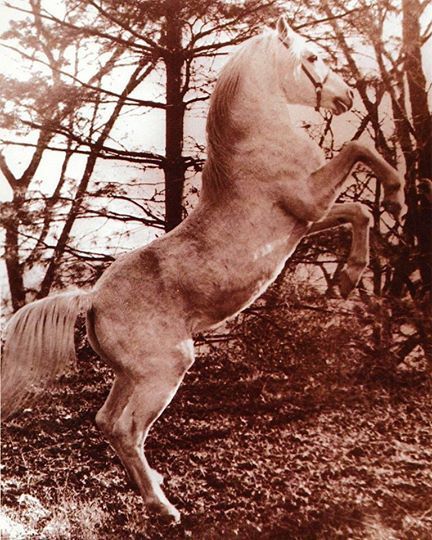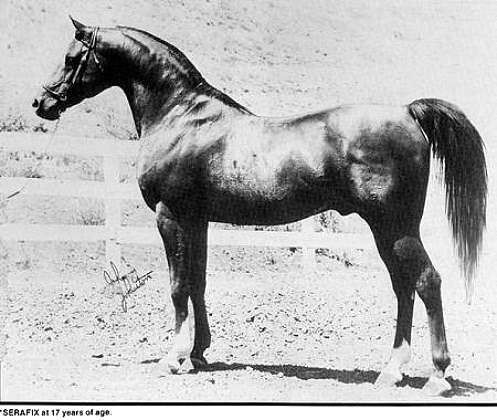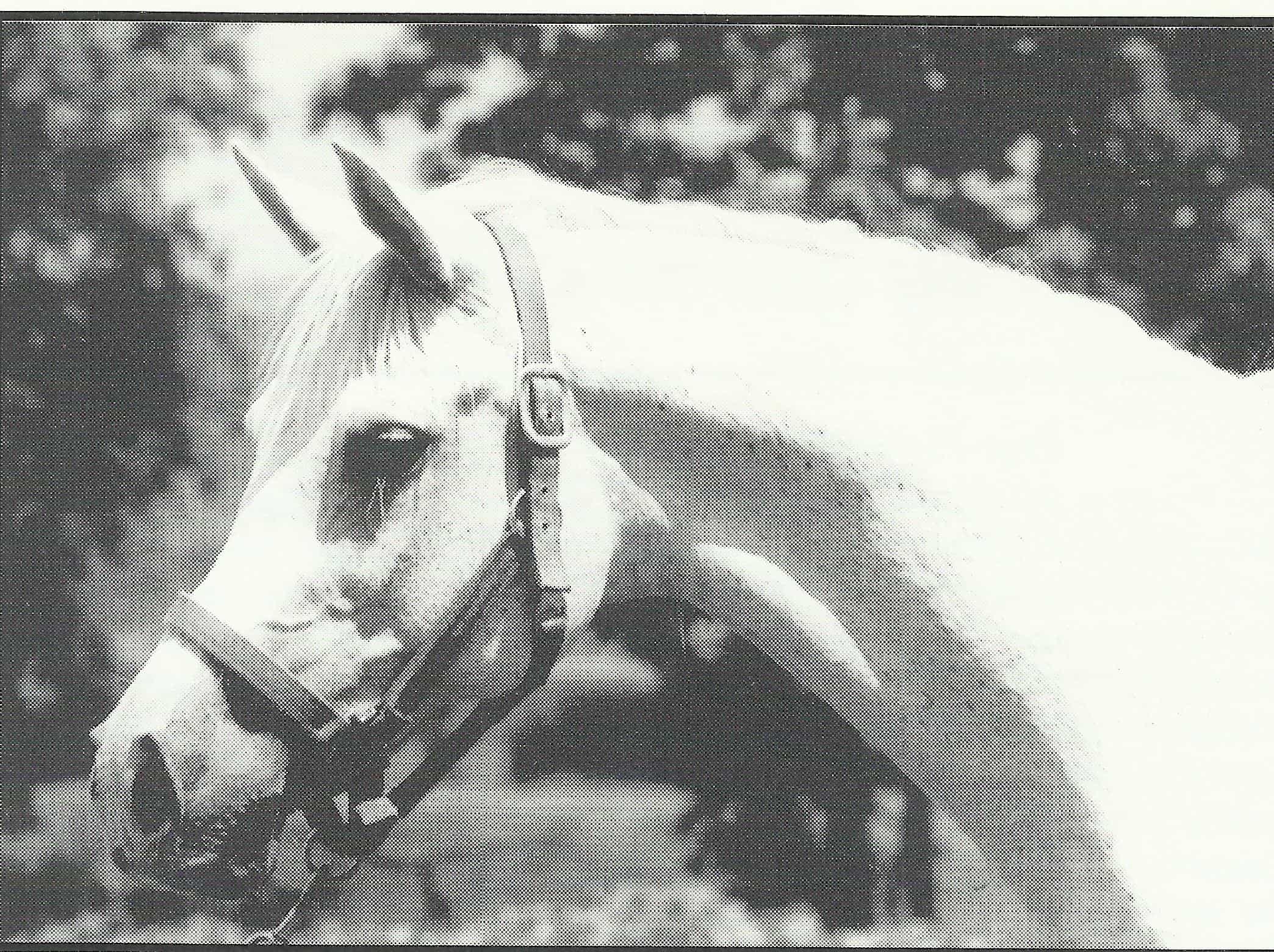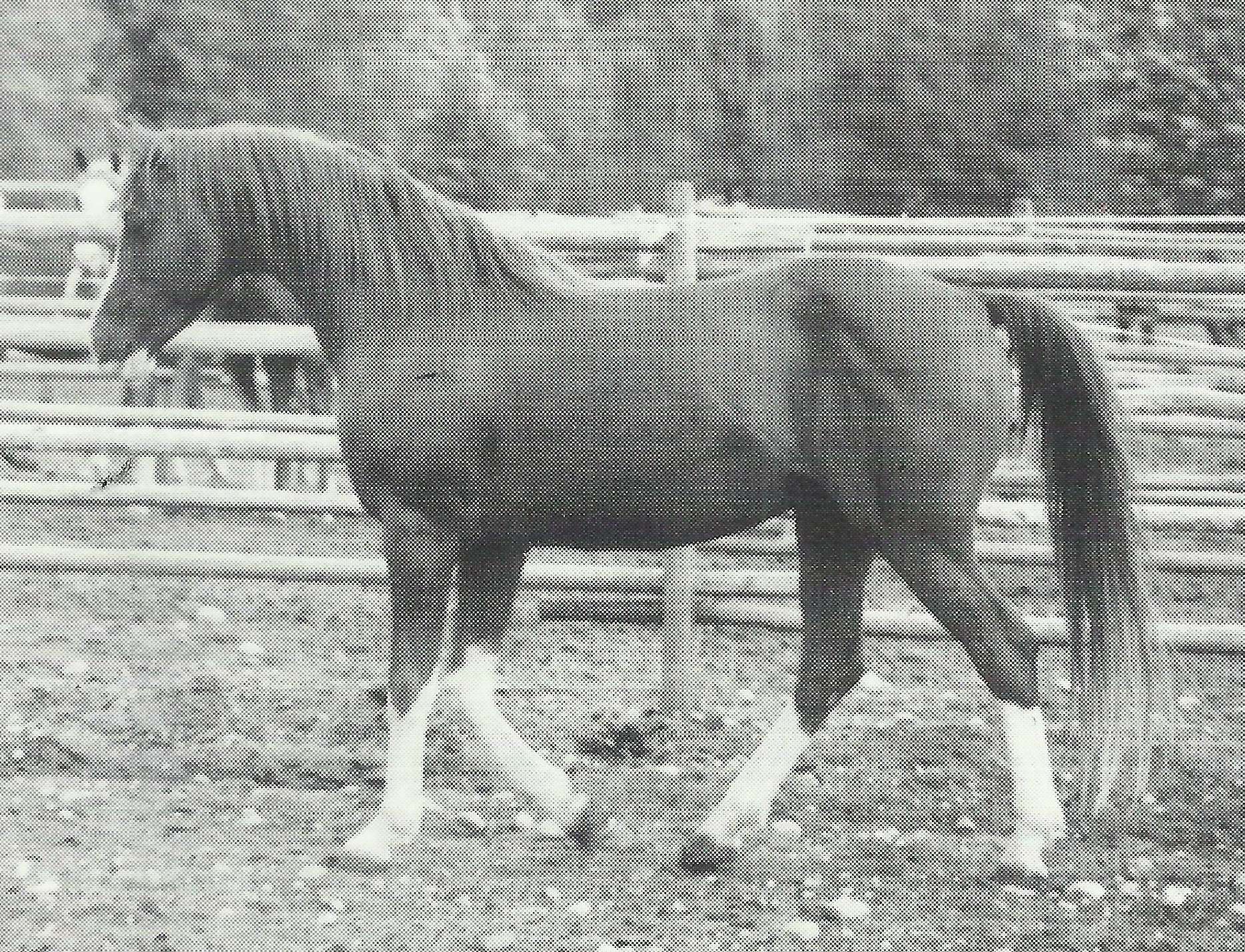By Karlan Downing, M.D.
** Originally printed in the 1989 Crabbet Yearbook.

When Lady Wentworth bred the Skowronek daughter, *Rifala, back to her sire in 1925, she could not have begun to imagine the influence that the resulting foal would have on the Arabian breed. When *Raffles was foaled his quality was apparent, but because of his small size Lady Wentworth planned to use him as a pony sire. In England good ponies are valued highly, as most juniors begin riding them and the fact that a horse is a sire of outstanding ponies is considered to be quite an accomplishment. *Raffles would have almost certainly sired outstanding ponies, except for one fact. He proved to be sterile!
Roger Selby, a shoe manufacturer and breeder of world champion American Saddlebreds, had become acquainted with Lady Wentworth on his many business trips to Europe and England. Over a period of time he gained her respect and finally was allowed back inside the barns at Crabbet Park, usually forbidden territory to visitors and potential purchasers who were shown only the horses that Lady Wentworth wished to sell. Selby, impressed by the beauty of the Arabians, made his first importation in 1928 which included *Rifala – *Raffles dam. Jimmy Dean, originally hired by Selby to train the Saddlebreds commented, “In those days not a lot was known about pedigrees, so Mr. Selby just bought horses he liked.” As a matter of fact, his third importation included four stallions and only one mare! *Raffles was included in this group, given to Mr. Selby as a riding horse for his children by Lady Wentworth. Mr. Selby’s daughter, Lois Selby Perry, laughed about this commenting, “She may have meant him for us, but certainly no attempt was ever made to train him as a child’s horse and he was not gelded, so my father must have had other plans for him.” Jimmy Dean figured that Selby didn’t want to insult Lady Wentworth by refusing the sterile stallion, and as a lover of beauty was most impressed with him. He was inbred to Skowronek, a horse that was sire or grandsire of eight out of the twenty horses Selby imported. Jimmy laughs, “I wouldn’t say that *Raffles wasn’t a kid’s horse. Any child could ride him that had been raised by the Indians riding bareback on wild Indian ponies all of their life!”
*Raffles was taken to the vet school at Ohio State, and again tested and found to be sterile. Jimmy felt that this was caused by the horse’s ‘hypertension’ and began a program to allow the horse to work off energy. The rest is history. In 1933, *Raffles was bred to the mares *Indaia and *Rishafieh. His career at stud was thus belatedly begun at age 11. The first foals were a shock. “All of his children looked alike, even the ones from the plainer mares.” Jimmy added that they had just never seen horses like them. “They had a classic beauty and although most of the mares had pretty plain heads by today’s standards, all of the *Raffles foals had short wedge shaped heads with large eyes set widely apart. They had very correct conformation and *Raffles’ cocky presence and vitality, with tails that were carried extremely high, almost as if they came out of the middle of their backs. We had never seen horses like this and we just didn’t know what to make of them.” Dr. Bill Munson probably summed it up, though. “At first I didn’t think that *Raffles was quite as nice as Image. But you didn’t have to be around there long or see many foal crops before you know there just wasn’t any other horse like *Raffles.”
*Raffles was a small but powerful horse. Breeder Paul McDannald when he first saw *Raffles was impressed with his correctness and beautiful head and especially with his huge eyes. Jimmy called him “the cock of the walk”. Lois commented about his extreme vitality, “He was always full of himself and radiated beauty and presence – even when he was dirty and muddy.” Bill Munson described him as “a little Banty rooster of a devil – he’d fight a buzz saw! In fact *Raffles often spent most of his free time challenging the huge Percheron stallion in the next paddock to mortal combat.”
While Jimmy was off showing the Saddlebreds the grooms and stable boys would often try to train the Arabians as five gaited horses. Their efforts were unsuccessful on *Raffles and their harsh methods left him quite a tough horse to handle. Until the day he died he considered the presence of a stick or whip in a person’s hand to be an overtly hostile gesture and retaliated in kind. Although he was never five gaited he did have extremely good action. In 1937 Selby Catalogue stated “His natural action is exceptionally high,” – quite a compliment coming from a catalog also containing Saddlebreds. *Raffles won the three gaited championship at the 1933 Nashville National Arabian Show. Lois and Jimmy both commented that despite his handling *Raffles was an intelligent horse. He would do anything you wanted if only you asked nicely.
Astute breeders like William States Jacobs, Gina Manion, and Herbert Tormohlen quickly recognized *Raffles’ potential as a sire and began sending their best mares to him. Over a period of time the general reluctance to use him because of his small size was overcome and he became the premier breeding horse at Selby Stud. His foals were in great demand and although he only sired 122 registered foals they include horses like the stallion, Indraff, who Bazy Tankersley purchased for the then unheard of price of $10,000. It proved to be a good buy, though, as Indraff probably appears in the pedigrees of more national winners than does *Bask.
As a 23-year-old *Raffles fractured a rear leg. Through casting and slinging the leg healed. He was then sold to Alice Payne (Asil Arabians) who had tried for years to purchase him. She began an extensive inbreeding program using him as essentially the only sire line in her herd. He died at her ranch in California in 1953, at the age of 27.
*Raffles certainly left his mark on the Arabian horse in the USA. Bill Munson called *Raffles “the best shortcut to a good broodmare band – when you bred to him all of the foals were good!” Paul McDannald made numerous trips in the early 1960′s to see all of the living *Raffles sons. “They were the most consistent group of horses I have ever seen, and their dams were of widely varying quality. He has to be the most prepotent horse I ever saw!” Lois adds “When looking at a group of horses in a pasture you can always pick out the *Raffles descendants – not just the sons and daughters. They just have a unique look that goes on for generations.” This prepotency has carried on to modern days through the efforts of breeders who have linebred and inbred *Raffles blood to unheard of extreme without apparent ill effect.
Skowronek, the sire of *Raffles, founded the leading sire line of U.S. National Champion Stallions (12 out of 32 – including Khemosabi, the leading living sire of champions) and leads the breed world wide as the leading sire line of national champions. *Rifala, *Raffles dam, was a champion in Great Britain as well as champion mare at the 1933 National Arabian Show in Nashville, TN. She also produced Image and Rifage – both sires of national winners – as well as the wonderful mare Ragala whose daughters produced national winners and numerous champions.
Is it any wonder then, that of the *Raffles get leaving offspring 43 percent produced national winners? Is it any surprise that although he died five years before the first U.S. National Championship Show he sired a U.S. Reserve National Champion Mare Rose of Raswan, and U.S. Top Ten Stallion – Mraff. Is it any surprise that his descendants are still noted for their type, correctness, quality and presence?
*Raffles is probably best summed up in the words of the Selby Catalogue, “Under all circumstances he makes such a perfect picture as to be truly fascinating – a picture Arab if there ever was one. His haughty carriage and vim make him the cynosure of all eyes…His kingly and animated demeanor would seem to indicate that he appreciates his superb superiority and his royal lineage, tracing further back than any human dynasty. The ideal Arab.”!
Sources:
*Raffles Sons and Daughters Who Have Produced National Winners by Arlene Magid – Arabian Horse Times, May 1987
Selby Stud Catalogue copyright 1937
Personal communication 1989:
Paul McDannald, Sarcoxie, MO
James Dean, Saunders, KY
Dr. William Munson, Harrison, NB
Lois Selby Perry, Agoura, CA






Deborah Rubin says
Raffles was one of the greats in my Arabian. My horse turned out to be sterile, which was fine since the breeder wouldn't have sold him to me (it was my mare he was bred to). Chief was funny and smart and took care of me when my spine was getting so bad I could hardly get on his back. Colic took him at age 25, a few weeks she of 26. It was 2001, and I still miss him.
I do enjoy seeing pictures of his ancestors.
Chelle Rogers says
Thank you so much for this article. I've owned two Arabs with heavy Raffles blood and both were classy, intelligent boys with super high spirits - just like I love my horses. Both lived in excellent health into late 20s and early 30s. I didn't have any idea Raffles was once thought to be sterile.